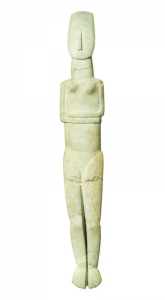Amorgos is a remarkably unspoiled island at the south-eastern edge of the Cyclades group, where traditional customs are still inextricably interwoven into a landscape as rich in beauty as in its history & culture. Originally inhabited by seafarers from Asia Minor in the 4th Century BC, the island now cradles people who enjoy a lifestyle that has been shaped by a varied and dramatic past. This is a place that appears untouched by time, but where the inhabitants quietly preserve one of the best kept secrets of the Aegean.
The length of the island is 33 kms and its width between 1,5 to 6 kms. There are three mountain peaks — Krikelos (822m) to the north, Profitis Ilias (699 metres) in the middle and Korax (607 metres) to the south-west. The dramatic mountain scenery provides a fine backdrop to some excellent walking.
Meadows and areas for cultivation, can be found in the area of Aegiali at the north, in Katapola at the centre, and at Arkesini the southern part of the island.
There are two ports on the island: of Katapola, and of Aegiali, where ferries, catamaran and hydrofoils call, connecting Amorgos with the other islands and the main land.
There are several beaches along the coast line. In Aegiali, the beach is long and sandy, and starts from the edge of the fishing village Ormos. “Levroso”, “Psili Ammos” and “Hohlakas” are 15 min. walk from the port, and can also be reached by small boat on a regular schedule.
In front of Aegiali bay, at the small uninhabited island of Nikouria, there are two nice sandy beaches, where small boats cross people for swimming, from the bay of “Agios Pavlos”. On this island, in antiquity there was a mint, making the coins of the 3 Ancient cities, of Minoa, Arkesini and Aegiali. Each city State, had its own currency, most of the coins depicting herbs and the head of Hypocrates.
On the other steep side of Amorgos, bellow the Byzantyne Monastery of Virgin Mary Chozoviotissa, the beach of Agia Anna, is famous for the clear blue and turquoise waters.Here is the location where the famous movie“Grand Blue” was filmed, which made Amorgos known around the world. Going south, at the same side of the island, “Mourou “ beach is very popular to all for the clear waters, the dark thick sand and the two caves where one can swim in. In Arkesini, “Kalotaritissa,” “Kato Kambos” and “Paradisia” beaches are some among others found at the South end of Amorgos.
HISTORY OF THE ISLAND
The island was first inhabited during the Neolithic period and 14 sites dating from the Early Cycladic period have so far been excavated. In antiquity there were three main cities on Amorgos, all founded in the 7th and 6th centuries BC. Remains of all three can still be seen. The island played important role in antiquity, due to the special geographic location. During the Middle Ages Amorgos was ruled by the Dukes of Naxos, but after the Byzantine Empire was restored to Constantinople, Amorgos was captured in 1268. Before the end of the century, however, the Venetians and Genoese defeated the Byzantines and Amorgos returned to the rule of the Dukes of Naxos until the Ottomans captured the island in 1566.
